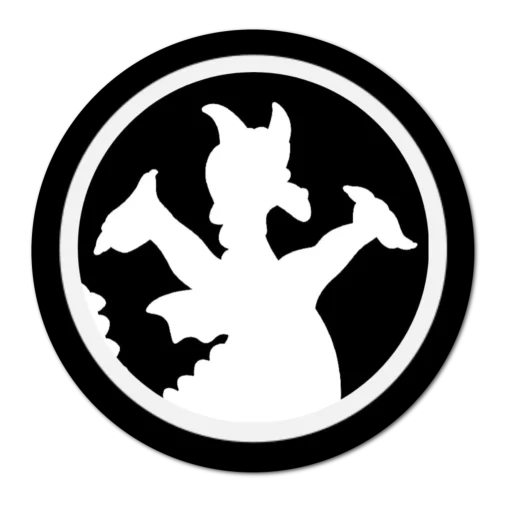If you could see close in my eyes, the American flag is waving in both of them and up my spine is growing this red, white and blue stripe.” – Walt Disney
Walt Disney may have been a master of fantasy, but his morals and values were rooted deeply in the history of the American dream. So too was much of Walt’s imagination and showmanship. From Main Street USA to New Orleans Square, Walt’s American pride shone through in his beloved Disneyland park. Walt’s love of Americana persisted in Walt Disney World, and even in the international Disney parks.
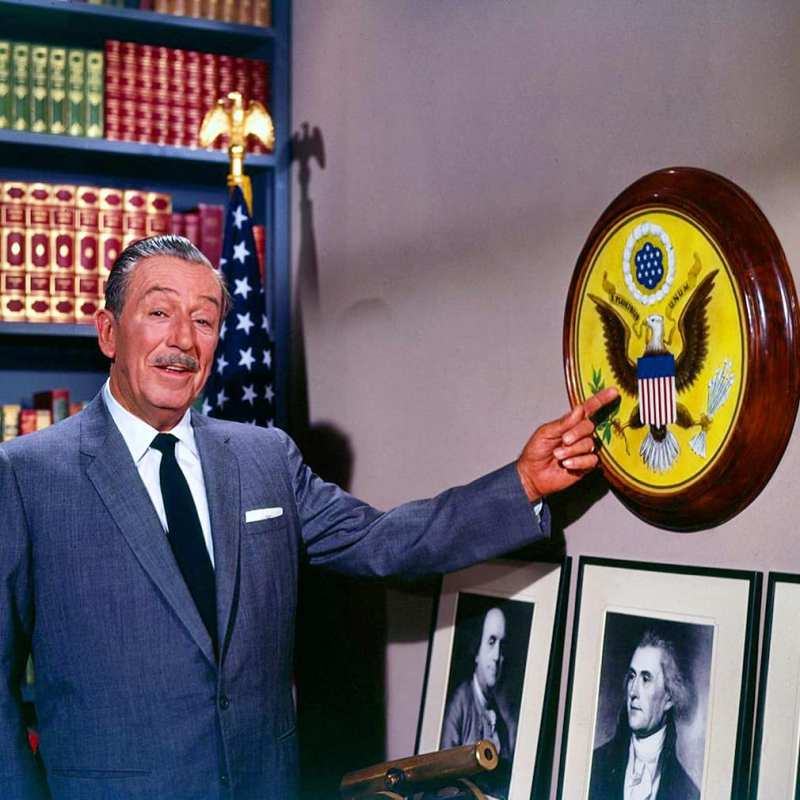
In today’s installment of Dearly Departed Disney, let’s take a look at two former attractions that once proudly sailed the Rivers of America through Magic Kingdom. Join us here as we travel back to America’s western frontier – from Disneyland, across the Mississippi to Florida.
Disneyland – Walt’s Wild Frontier
“Frontierland – tall tales and true from the legendary past.” – Introduction to Walt Disney’s Disneyland television show – 1954
When Walt Disney was producing his Disneyland television show in the 1950s, he wanted a good western feel to set the stage for the Frontierland section of his planned Disneyland park. Not only did Walt want a western theme. He wanted the land – and the stories that celebrated it – to be authentic and at least partly based on actual American history. It was through this ambition of Walt’s that two American folk figures found their way to Frontierland.
Setting the Stage
Beginning in December 1954, Walt released a series of three thirty-minute short films about the American frontier legend Davy Crockett. The episodes aired on the Disneyland show for three consecutive months, ahead of the park opening. The title character was an American folk hero, frontiersman, soldier, and politician, and he was played by Disney Legend Fess Parker. The release of the short films quickly grew popular to American audiences. In response to the demand for more Crockett, Disney stitched the three films together following their television appearances, and released them collectively in theaters as a single feature film – Davy Crockett: King of the Wild Frontier.
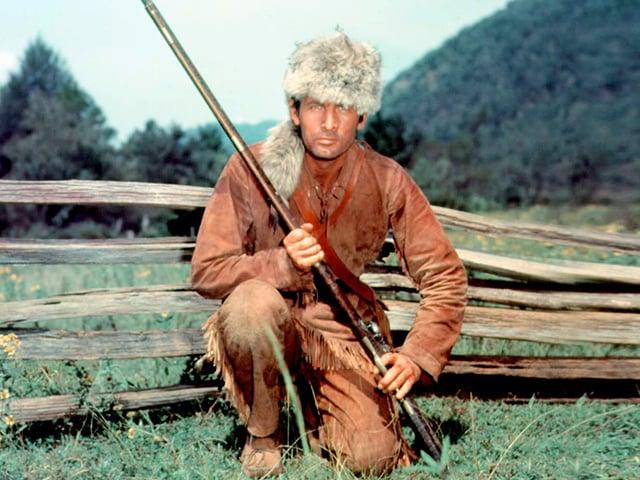
And with that, frontier fever was born. Millions of boys proudly wore their coonskin caps, and The Ballad of Davy Crockett was constantly playing on radios worldwide. The Davy Crockett episodes of the Disneyland television show were the most popular in the series to date. In fact, no other piece to be aired on the Disneyland series would ever surpass Davy Crockett in popularity.
When we fast-forward to the current time, it’s easy to think of Davy Crockett as an outdated hero from a different age. That is essentially what he is to modern audiences. But in order to fully appreciate Disney’s Frontierland, one first needs to understand the magnitude of Davy Crockett in his day. Davy Crockett in the 1950s might compare in popularity to Harry Potter in the 2000s, or Anna and Elsa over the last decade. The King of the Wild Frontier was American film’s greatest hero of his day.
Davy Crockett Goes to Disneyland
With American audiences primed and ready for Disneyland, Davy Crockett and the American frontier were installed as the face of Frontierland. So it was no surprise when a canoe attraction opened in the park on Independence Day 1956 – named Indian War Canoes. The immense popularity of Davy Crockett and his adventures in Native American lands raged on for several years. But even after the hottest flames began to cool, the presence of Davy Crockett throughout Disneyland’s Frontierland continued to draw big crowds.
In 1971, the Indian War Canoes were rethemed and renamed Davy Crockett Explorer Canoes. Guests looking for some time on the water happily boarded a 35-foot long canoe from a dock in a portion of Frontierland that was renamed Bear Country. From there, guests travelled the Rivers of America, along with the Mark Twain Riverboat and Mike Fink Keel Boats, exploring the sights and sounds of America’s idealistic frontier.
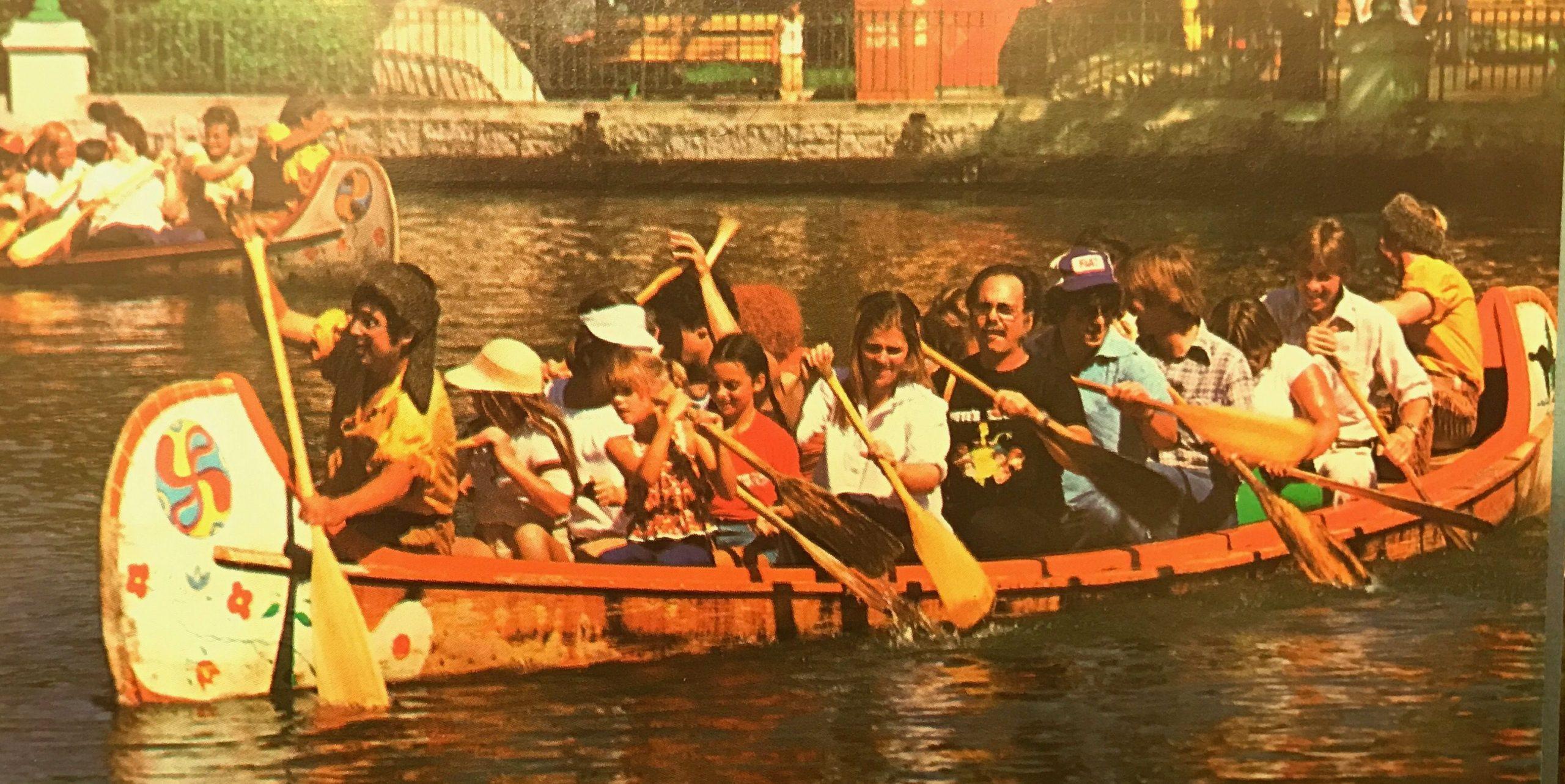
Disneyland Fun Fact: In 1989, Disneyland’s Bear Country was again rethemed – this time to Critter Country. With this name change, the canoe gained the distinction of being the only attraction to reside in three different lands over the years, without ever moving locations. The only other attraction that may be considered to be located in three lands are the Disney railroads, by virtue of having multiple stations along the rail route.
The canoes were piloted by two Cast Members wearing Crockett’s signature coonskin caps. One pilot sat in the bow of the canoe, and the other sat in the stern. Guests filled the remainder of the canoe in between the pilots. Guests on the canoes participated in powering the attraction, rowing the canoe along its prescribed path. In fact, the pilots often warned the guests “if you don’t row, we don’t go!”
A “Punny” Adventure
Similar to the iconic Jungle Cruise attraction, one of the canoe’s pilots would entertain guests with a joke-filled spiel. Here are a few of the more well remembered quips:
- (Pilot introduces himself to the guests in the canoe.) “I’m your captain, alligator wrestler, and possibly your swimming instructor!”
- (Pilot points to a burning settler’s cabin along the river.) “My girlfriend left me. That’s her house up there. We had a heated argument, sparks began to fly and she burned me up so I’m burning her down. I guess you can call her an old flame.”
- “One of the original Mouseketeers is here with us today! Here’s ‘a net’!” (pilot holds up a net.) Like Davy Crockett himself, this joke was a product of its time, when Annette Funicello was a big star on Disney’s Mickey Mouse Club television show.
- And of course, an almost carbon-copy of one of the most popular Jungle Cruise jokes: (Points to Big Thunder Mountain.) “See Big Thunder Mountain on our left? It’s made of 100% sandstone so don’t take it for granite.”
- Upon exiting the canoe, guests may have been encouraged to leave in this manner: “I’m going to tell you what my father told me at 18. Get up. Get out. The free ride’s over. And take your mother with you!”
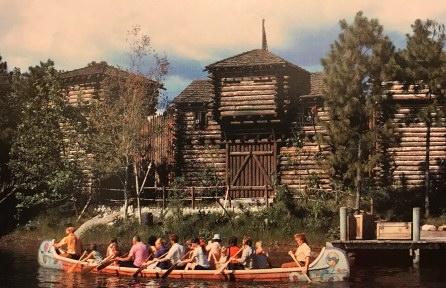
Crossing the Mississippi
When Magic Kingdom was being planned in the late 1960s, most of the same themed lands were inspired by the Disneyland blueprint. Magic Kingdom’s Frontierland drew on most of what worked so well in Disneyland – namely Davy Crockett and Tom Sawyer.
Davy Crockett Explorer Canoes debuted in Magic Kingdom’s Frontierland on opening day in 1971 – the same year Disneyland’s Indian War Canoes were renamed for the King of the Wild Frontier. In the Magic Kingdom, paddlers boarded their canoe from a dock located just north of Tom Sawyer Island’s raft launch. From there, they rowed the Rivers of America in similar fashion to their Disneyland counterparts.
Davy Crockett Explorer Canoes were never quite as popular in Magic Kingdom as they were in Disneyland. Initially, they ran on a regular schedule, but before too long they were often listed in park guides as being open only seasonally. The canoes last operated in 1993, and closed permanently in 1994.
Guests looking for an upper body workout can still row the canoes in Disneyland, in what is now known as Critter Country. Tokyo Disneyland and Shanghai Disneyland also have their own canoe attractions.
Mike Who?
Walt Disney was a master of synergy and promotion. The three episodes in the Davy Crockett miniseries, which were simply meant to highlight the Frontierland section of Disneyland, became a national phenomenon. Following the successful opening of Disneyland in July 1955, Disney doubled down on Crockett fever while the iron was still hot. Two more episodes were added to the series in late 1955, bringing the total to five episodes. The additional two films were stitched together much like the first three had been, and were shown in movie theaters as Davy Crockett and the River Pirates.
The first of the final two Davy Crockett episodes – Davy Crockett’s Keelboat Race – introduced fans to another memorable character – Mike Fink. In the episode, Crockett and his companion Russel are fur trapping in Kentucky when they meet Fink, known regionally as the best boatman around. Fink challenges Crockett to a keelboat race to New Orleans. Crockett’s Bertha Mae beat out Fink’s Gullywhumper for the title of King of the River.
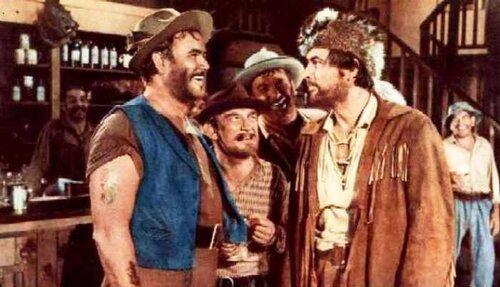
Just as Walt presented – Davy Crockett was an American folk legend.
Mike Fink Keel Boats in Disneyland (1955-1997)
Well, since Disneyland was planning to offer a canoe attraction, it only made sense to crowd the river a bit more with Mike Fink’s keel boats. So it was that Mike Fink Keel Boats opened in the park on Christmas Day 1955 – a little over six months before the Indian War Canoes.
The keel boat experience was very simple for guests. After boarding the watercraft and leaving the dock, the free-floating, motorized boats would sail around Tom Sawyer Island to view scenery around the Rivers of America.
The original Disneyland keel boats were the actual boats used in the filming of the Davy Crockett programs – converted to guest-friendly vehicles with seats and windows on each side. The original keel boats were later replaced by higher-capacity boats with more windows on each side.
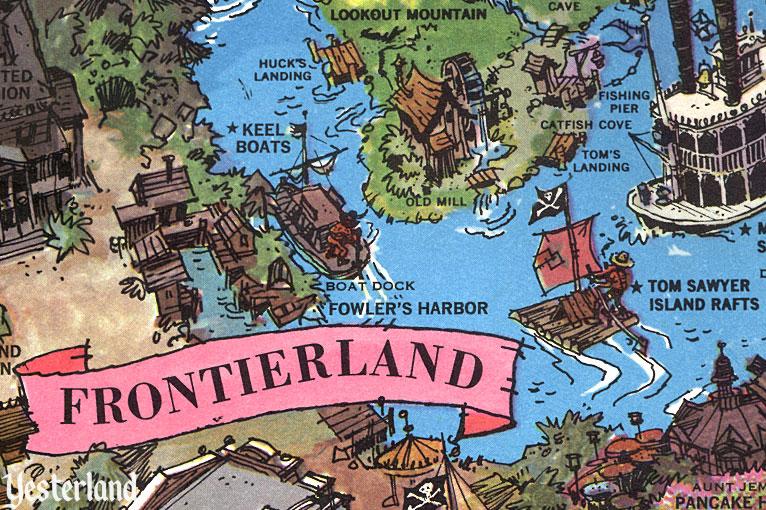
Similar to the canoe attraction, Walt Disney World designers were looking to draw on Disneyland’s successes for use in Magic Kingdom. So it was that Crockett’s friendly rival Mike Fink made his way to Florida as well.
Mike Fink Keel Boats in Magic Kingdom (1971-2001)
The Mike Fink Keel Boats debuted at Walt Disney World on opening day 1971. Just like in the film, and in Disneyland, there were two keel boats – the Bertha Mae and the Gullywhumper. Davy Crockett diehards might have preferred a seat on Crockett’s Bertha Mae, with its louvered and decorated shutters. Pals of Mike Fink would enjoy the Gullywhumper, with its simple, barn-like shutters.
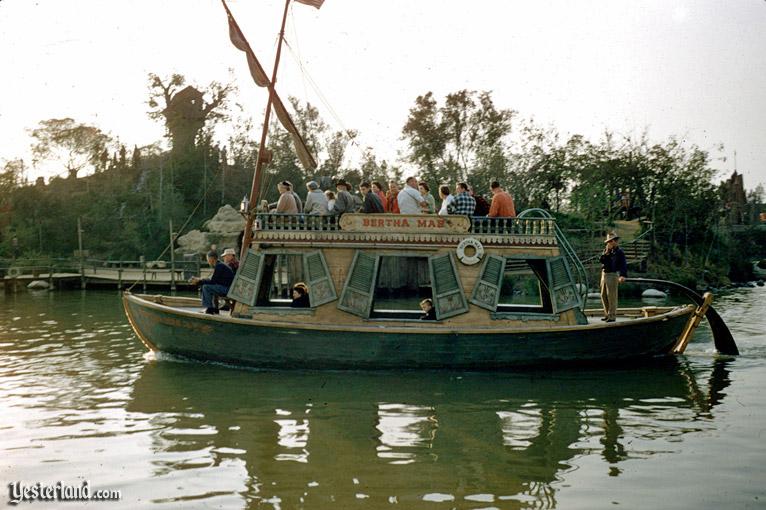
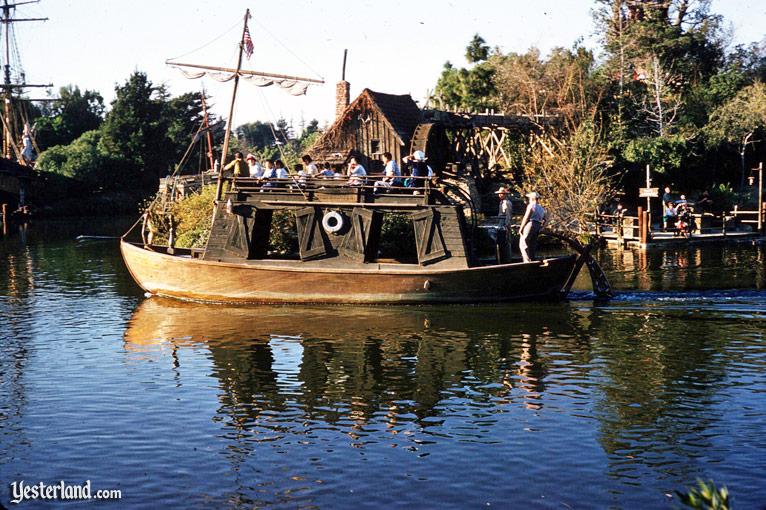
Boarding for the keel boats differed a bit from in Disneyland, taking place near the entrance to the Haunted Mansion. Otherwise, the guest experience was almost identical to the Disneyland experience.
Magic Kingdom Fun Fact: The free-floating keel boats came in handy during one of the Magic Kingdom’s preview days before the park opened in 1971. During preview days, only three of the Walt Disney World monorail trains were in service. To assist with some of the guest traffic, one of the keel boats was temporarily used to shuttle additional guests across the Seven Seas Lagoon from the Transportation and Ticket Center to the main gates!
The Gullywhumper Goes Topsy Turvy
The keel boats in Magic Kingdom operated into 2001, outlasting their Disneyland counterparts by about four years. The reason for this? Well, in May 1997, Disneyland’s Gullywhumper began rocking from side to side while on a routine trip on the river. The watercraft tipped over, dumping a boatload of guests into the Rivers of America. Several guests were treated at a nearby hospital for minor injuries. Following the accident, the Gullywhumper was removed from the water for inspection. Neither the Gullywhumper nor the Bertha Mae would ever sail in Disneyland again.
From that day on, Mike Fink’s days in Magic Kingdom were numbered. The keel boats continued to sail for a few more seasons, until they docked for the final time on April 29, 2001.
These boats from a different age may no longer sail the waters of Magic Kingdom, but at last check, the keel boat dock is still located near Liberty Square.
Davy Crockett and Mike Fink are no longer prominent in Magic Kingdom’s Frontierland, and no specific attractions replaced them. They seem to have been simply lost to a generational transition. However, guests with an eye toward Disney Parks history may be able to spot hints of their previous existence. It may be a shame to have lost two all-American attractions, but Walt never intended his parks to be museums. The constant evolution of the Disney parks is a testament to Walt’s philosophy of always moving forward and doing new things.
Thanks for riding, and please follow along here for additional articles in this series. We’ll continue to explore many other former attractions and experiences from Walt Disney World, including Magic Kingdom, Epcot, Hollywood Studios, and Animal Kingdom.
If you enjoyed this article, please feel free to share it with friends.
Follow Facts and Figment on social media: Instagram Facebook X
Sources referenced in writing this article include:
Yesterland – Indian War Canoes
